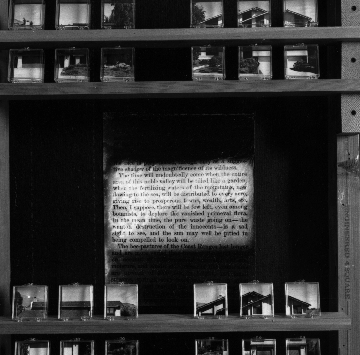
Detail from "Black Material" by John Wilson White



|
The exhibition
of sound and video installations, sculpture, and visual and conceptual art takes place in two venues: the Busfield home at 876 Rose Drive (two installations), and the Arts Benicia Center Gallery at 991 Tyler St.
The seven Bay Area artists whose work was inspired by the evacuated homes don't live in the community, says Kathryn Gunther, Director of Arts Benicia gallery. The toxic backyard sludge, erupting from sink holes, that shattered the security of family life in this sunny, Eden-like, small town neighborhood roughly 30 miles north of Berkeley -- a far cry from inner city slums or poorer ethnic suburban enclaves that are known targets of toxic dumping -- has catalyzed a strong response. Alameda artists Trena Noval and James Gouldthorpe, in collaboration with the Busfield family, have created "Home," ("...is where the heart is"), an oral history of the family residence, and metaphor for the lost security that it once represented. Its site-specific component is an audiotape activated by the doorbell at the family's former home, recalling domestic life there; its gallery counterpart is an audiovisual walking tour of the house interior, narrated by Lynn Busfield. Susan Leibovitz Steinman's "Garden for Rose Drive," a second on-site work, calls more attention to the ordinary, four bedroom, two-car garage house, than does its weedy lawn, which breaks rank with the well clipped ones of its empty neighbors, that the developer meticulously maintains. Steinman has plunked cheery flowers into bright yellow-painted tire planters and upturned red, earth-filled mailboxes which obstruct the driveway. These are conventionalized warnings from shrill, traditional suburban icons. The artist softened the family's hard-edged garage door protest, preserved in a photograph displayed at the gallery ("1788 Days and no resolution from Southhampton...") by repainting the door pale blue, streaked with clouds and a quote from Wendell Berry: "The field must remember the forest, the town must remember the field so that the wheel of life will turn and the dying be met by the newborn." Work such as this raises issues that are anathema to small town real estate and tourist industries, serious questions that residents of small suburban towns across America are now facing. Artist Kate Randall, who was growing up near Three Mile Island Nuclear power plant when the accident occurred there in 1978, has contributed "Equations," a piece which details threshold levels of these substances which cause harmful effects in humans. And San Franciscan John Wilson White's "Black Material" simulates a partly constructed house interior on which text excerpts documenting regional land use decisions, are posted eratically between exposed studs; and small, neatly cut-up photos of impacted houses along Rose Drive are asceptically displayed in contiguous, small, flat plastic boxes. Other artists whose work appears in the show have used so- called "waste" in sculptural, kinetic, painterly, photographic, and metaphorical ways, to probe connections between waste management and new technology (including waste-eating plants), create industrial artifacts, and weigh the values of competing land uses.
|
Albion Monitor June, 1996 (http://www.monitor.net/monitor)
All Rights Reserved.
Contact rights@monitor.net for permission to reproduce.